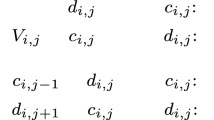Abstract
We explore the complexity and exact computation of a variant of the classical stable marriage problem in which we seek matchings that are not only stable, but are also “fair” in a formal sense. In particular, we study the sex-equal stable marriage problem (SESM), in which, roughly speaking, we wish to find a stable matching with the property that the men’s happiness is as close as possible to the women’s happiness. This problem is known to be strongly NP-hard (Kato in Jpn. J. Ind. Appl. Math. 10:1–19, 1993).
We specifically consider SESM instances in which the preference lists of the men and/or women are bounded in length by a constant. On the negative side, we show that SESM is NP-hard, even if both the men’s and women’s preference lists are of length at most three, and is not even in the class XP when parameterized by the objective value of the solution. This strengthens the NP-hardness results of Kato (Jpn. J. Ind. Appl. Math. 10:1–19, 1993). On the positive side, we show that our hardness result is “tight” by giving a polynomial-time algorithm for the case in which the preference lists on one side (say the men) are of length at most two, and the lengths of the lists on the other side (the women) are unbounded. Furthermore, we give a low-order exponential-time algorithm for SESM in which the preference lists on one side are of length at most l (and the lengths of the lists on the other side are unbounded). In particular, for every pair of constants \(l \in\mathcal{Z}^{+}\) and \(\epsilon\in\mathcal{R}^{+}\) there is an algorithm with running time bounded by \(O^{\star}(2^{(5 - \sqrt{24})(l-2 + \epsilon)n}) + O^{\star}(2^{\frac {(l-1)}{2\epsilon}})\). Hence, if ϵ is chosen to be a sufficiently small constant, the running time is in O ⋆(1.0726n), O ⋆(1.1504n), O ⋆(1.2339n),… for l=3,4,5,… .


Similar content being viewed by others
Notes
Gale and Shapley actually consider the restriction of SMI in which each man ranks every woman on his preference list, and each woman ranks every man on her preference list. Their results clearly generalize to the SMI case.
The study of stable matching problems with preference lists that are of fixed or bounded length on one side is motivated by practical applications, such as matching medical students to hospitals, in which such a restriction usually applies.
There has been much recent interest in exact exponential-time algorithms for computationally hard problems. We refer the reader to the survey of Woeginger [21].
We use the standard O ⋆ notation that suppresses polynomial factors in any terms to analyze the running time of an exponential-time algorithm.
References
Bodlaender, H.: A tourist guide through treewidth. Acta Cybern. 11(1–2), 1–23 (1993)
Cheng, C.: Understanding the generalized median stable matchings. Algorithmica 58(1), 34–51 (2010)
Edwards, K., Farr, G.: Planarization and fragmentability of some classes of graphs. Discrete Math. 308, 2396–2406 (2008)
Feder, T.: Stable networks and product graphs. Ph.D. Thesis, Stanford University, 1990 (Published in Memoirs of the American Mathematical Society, 116(555), (1995))
Gale, D., Shapley, L.S.: College admissions and the stability of marriage. Am. Math. Mon. 69, 9–15 (1962)
Gusfield, D.: Three fast algorithms for four problems in stable marriage. SIAM J. Comput. 16(1), 111–128 (1987)
Gusfield, D., Irving, R.W.: The Stable Marriage Problem: Structure and Algorithms. MIT Press, Cambridge (1989)
Gale, D., Sotomayor, M.: Some remarks on the stable matching problem. Discrete Appl. Math. 11, 223–232 (1985)
Irving, R.W., Leather, P.: The complexity of counting stable marriages. SIAM J. Comput. 15(3), 655–667 (1986)
Irving, R.W., Leather, P., Gusfield, D.: An efficient algorithm for the “optimal” stable marriage. J. ACM 34(3), 532–543 (1987)
Iwama, K., Miyazaki, S., Yanagisawa, H.: Approximation algorithms for the sex-equal stable marriage problem. ACM Trans. Algorithms 7(1), Article No. 2 (2010)
Johnson, D.S., Niemi, K.A.: On knapsacks, partitions, and a new dynamic programming technique for trees. Math. Oper. Res. 8(1), 1–14 (1983)
Kato, A.: Complexity of the sex-equal stable marriage problem. Jpn. J. Ind. Appl. Math. 10, 1–19 (1993)
Kijima, S., Nemoto, T.: Finding a level ideal of a poset. In: Proceedings of COCOON’09: The 15th International Computing and Combinatorics Conference. Lecture Notes in Computer Science, pp. 317–327. Springer, Berlin (2009)
Knuth, D.E.: Mariages Stables. Les Presses de L’Université de Montréal, Montréal (1976)
Marx, D., Schlotter, I.: Stable assignment with couples: parameterized complexity and local search. Discrete Optim. 8(1), 25–40 (2011)
Marx, D., Schlotter, I.: Parameterized complexity and local search approaches for the stable marriage problem with ties. Algorithmica 58(1), 170–187 (2010)
Niedermeier, R.: Invitation to Fixed-Parameter Algorithms. Oxford University Press, London (2006)
Teo, C., Sethuraman, J.: The geometry of fractional stable matchings and its applications. Math. Oper. Res. 23(4), 874–891 (1998)
Valdes, J., Tarjan, R.E., Lawler, E.L.: The recognition of series parallel digraphs. SIAM J. Comput. 11(2), 298–313 (1982)
Woeginger, G.J.: Open problems around exact algorithms. Discrete Appl. Math. 156(3), 397–405 (2008)
Acknowledgements
We wish to thank an anonymous reviewer for valuable comments and suggestions, and for detecting an error in a previous draft.
Author information
Authors and Affiliations
Corresponding author
Additional information
E. McDermid and R.W. Irving were supported by EPSRC grant EP/E011993/1.
E. McDermid was supported by UWM Research Growth Initiative.
Part of this work was completed while E. McDermid was at the School of Computing Science, University of Glasgow and the Computer Science Department, University of Wisconsin-Milwaukee.
Rights and permissions
About this article
Cite this article
McDermid, E., Irving, R.W. Sex-Equal Stable Matchings: Complexity and Exact Algorithms. Algorithmica 68, 545–570 (2014). https://doi.org/10.1007/s00453-012-9672-0
Received:
Accepted:
Published:
Issue Date:
DOI: https://doi.org/10.1007/s00453-012-9672-0




